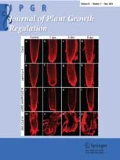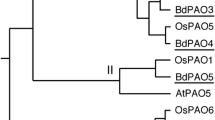Abstract
To characterize polyamine (PA) biosynthetic pathways in Brachypodium distachyon, we analyzed the gene-expression patterns and PA contents in various organs. Three major PAs—putrescine (Put), spermidine (Spd), and spermine (Spm)—were detected, but thermospermine (T-Spm) was below the sensitivity limit of high-performance liquid chromatography in all tissues examined, although expression of the ACL5 gene, which is known as the T-Spm synthesis gene, was confirmed. In leaves, Put was the most abundant PA, and its level of accumulation was more than three times greater than those of Spd and Spm. In contrast, the primary PA in other organs was Spd. A high correlation was observed between arginine decarboxylase (ADC) gene-expression patterns and Put contents under normal growth conditions. These results indicate that Put is normally synthesized through the ADC pathway. We also analyzed salt stress responses and confirmed that all PA biosynthesis genes are induced by NaCl treatment. Moreover, Spm highly accumulated under salt stress conditions. Recently, T-Spm was shown to enhance the translation of Arabidopsis SAC51 family mRNAs, at least SAC51 and SACL1, by reducing the inhibitory effect of the conserved upstream open reading frame (uORF). Through database analysis, three and five SAC51 family genes were identified from B. distachyon and Zea mays, respectively. However, these genes are most closely related to SACL3 in Arabidopsis, and the commonly conserved uORF sequence was not confirmed for some of these genes. Therefore, the function of T-Spm in monocotyledonous plant species might be different from that in Arabidopsis.









Similar content being viewed by others
References
Cai Q, Fukushima H, Yamamoto M, Ishii N, Sakamoto T, Kurata T, Motose H, Takahashi T (2016) The SAC51 family plays a central role in thermospermine responses in Arabidopsis. Plant Cell Physiol 57:1583–1592
Clay NK, Nelson T (2005) Arabidopsis thickvein mutation affects vein thickness and organ vascularization, and resides in a provascular cell-specific spermine synthase involved in vein definition and in polar auxin transport. Plant Physiol 138:767–777
Draper J, Mur LA, Jenkins G, Ghosh-Biswas GC, Bablak P, Hasterok R, Routledge AP (2001) Brachypodium distachyon. A new model system for functional genomic in grasses. Plant Physiol 127:1539–1555
Fariduddin Q, Varshney P, Yusuf M, Ahmad A (2013) Polyamines: potent modulators of plant responses to stress. J Plant Interact 8:1–16
Gupta K, Dey A, Gupta B (2013) Plant polyamines in abiotic stress responses. Acta Physiol Plant 35:2105–2036
Hamana K, Matsuzaki S (1985) Distinct difference in the polyamine compositions of Bryophyta and Pteridophyta. J Biochem 97:1595–1601
Hanzawa Y, Takahashi T, Michael AJ, Burtin D, Long D, Pineiro M, Coupland G, Komeda Y (2000) ACAULIS5, an Arabidopsis gene required for stem elongation, encodes a spermine synthase. EMBO J 19:4248–4256
Hayden CA, Jorgensen RA (2007) Identification of novel conserved peptide uORF homology groups in Arabidopsis and rice reveals ancient eukaryotic origin of select groups and preferential association with transcription factor-encoding genes. BMC Biol 5:32. https://doi.org/10.1186/1741-7007-5-32
Hong S-Y, Seo PJ, Yang M-S, Xiang F, Park C-M (2008) Exploring valid reference genes for gene expression studies in Brachypodium distachyon by real-time PCR. BMC Plant Biol 8:112. https://doi.org/10.1186/1471-2229-/8/112
Hussain SS, Ali M, Ahmad M, Siddique KHM (2011) Polyamines: natural and engineered abiotic and biotic stress tolerance in plants. Biotech Adv 29:300–311
Imai A, Hanzawa Y, Komura M, Yamamoto KT, Komeda Y, Takahashi T (2006) The dwarf phenotype of the Arabidopsis acl5 mutant is suppressed by a mutation in an upstream ORF of a bHLH gene. Development 133:3575–3585
Kakehi J-I, Kuwashiro Y, Niitsu M, Takahashi T (2008) Thermospermine is required for stem elongation in Arabidopsis thaliana. Plant Cell Physiol 49:1342–1349
Kakehi J, Kuwashiro Y, Motose H, Igarashi K, Takahashi T (2010) Norspermine substitutes for thermospermine in the control of stem elongation in Arabidopsis thaliana. FEBS Lett 584:3042–3046
Kasinathan V, Wingler A (2004) Effect of reduced arginine decarboxylase activity on salt tolerance and on polyamine formation during salt stress in Arabidopsis thaliana. Physiol Plant 121:101–107
Kasukabe Y, He L, Watakabe Y, Otani M, Shimada T, Tachibana S (2006) Improvement of environmental stress tolerance of sweet potato by introduction of genes for spermidine synthase. Plant Biotech 23:75–83
Kitayama H, Iwamoto K, Kariya Y, Asakawa T, Kan T, Fukuda H, Ohashi-Ito K (2015) A negative feedback loop controlling bHLH complexes is involved in vascular cell division and differentiation in the root apical meristem. Cull Biol 25:3144–3150
Knott JM, Römer P, Sumper M (2007) Putative spermine synthases from Thalassiosira pseudonana and Arabidopsis thaliana synthesize thermospermine rather than spermine. FEBS lett 581:3081–3086
Koc EC, Bagga S, Songstad DD, Betz SR, Kuehn GD, Phillips GC (1998) Occurrence of uncommon polyamines in cultured tissues of maize. In Vitro Cell Dev Biol-Plant 34:252–255
Krishnamurthy R, Bhagwat KA (1989) Polyamine as modulators of salt tolerance in rice cultivars. Plant Physiol 91:500–504
Kumar S, Stecher G, Tamura K (2016) MEGA7: molecular evolutionary genetics analysis version 7.0 for bigger datasets. Mol Biol Evol 33:1870–1874
Liu J, Yu B-J, Liu Y-L (2006) Effects of spermidine and spermine levels on salt tolerance associated with tonoplast H+-ATPase and H+-PPase activities in barley roots. Plant Growth Regul 49:119–126
Minocha R, Majumdar R, Minocha SC (2014) Polyamines and abiotic stress in plants: a complex relationship. Front Plant Sci 5:175
Munns R, Tester M (2008) Mechanisms of salinity tolerance. Annu Rev Plant Biol 59:651–681
Naka Y, Watanabe K, Sagor GHM, Niitsu M, Pillai MA, Kusano T, Takahashi Y (2010) Quantitative analysis of plant polyamines including thermospermine during growth and salinity stress. Plant Physiol Biochem 48:527–533
Neily MH, Baldet P, Arfaoui I, Saito T, Li Q-I, Asamizu E, Matsukura C, Moriguchi T, Ezura H (2011) Overexpression of apple sperumidine synthase 1 (MdSPDS1) leads to significant salt tolerance in tomato plants. Plant Biotech 28:33–42
Pang X-M, Zhang Z-Y, Wen X-P, Ban Y, Moriguchi T (2007) Polyamines, all-purpose players in response to environment stresses in plants. Plant Stress 1:173–188
Pathak MR, Teixeira da Silva JA, Wani SH (2014) Polyamines in response to abiotic stress tolerance through transgenic approaches. GM Crops Food 5:87–96
Pegg AE, Michael AJ (2010) Spermine synthase. Cell Mol Life Sci 67:113. https://doi.org/10.1007/s00018-009-0165-5
Rodriguez-Garay B, Phillips GC, Kuehn GD (1989) Detection of norspermidine and norspermine in Medicago sativa L. (alfalfa). Plant Physiol 89:525–529
Roy M, Wu R (2001) Arginine decarboxylase transgene expression and analysis of environmental stress tolerance in transgenic rice. Plant Sci 160:869–875
Roy M, Wu R (2002) Overexpression of S-adenosylmethionine decarboxylase gene in rice increase polyamine level and enhances sodium chloride-stress. Plant Sci 163:987–992
Takahashi Y (2016) The role of polyamines in plant disease resistance. Environ Control Biol 54:17–21
Takahashi T, Kakehi J-I (2010) Polyamines: ubiquitous polycations with unique roles in growth and stress responses. Annal Bot 105:1–6
Takano A, Kakehi J-I, Takahashi T (2012) Thermospermine is not a minor polyamine in the plant kingdom. Plant Cell Physiol 53:606–616
The International Brichyposium Initiative (2010) Genome sequencing and analysis of the model grass Brachypodium distachyon. Nature 463:763–768
Thompson JD, Higgins DG, Gibson TJ (1994) CLUSTAL W: improving the sensitivity of progressive multiple sequence alignment through sequence weighing, positions-specific gap penalties and weight matrix choice. Nucleic Acids Res 22:4673–4680
Urano K, Yoshiba Y, Nanjo T, Igarashi Y, Seki M, Sekiguchi F, Yamaguchi-Shinozaki K, Shinozaki K (2003) Characterization of Arabidopsis genes involved in biosynthesis of polyamines in abiotic stress responses and developmental stages. Plant Cell Environ 26:1917–1926
Urano K, Yoshiba Y, Nanjo T, Ito T, Yamaguchi-Shinozaki K, Shinozaki K (2004) Arabidopsis stress-inducible gene for arginine decarboxylase AtADC2 is required for accumulation of putrescine in salt tolerance. Biochem Biophys Res Commun 313:369–375
Vera-Sirera F, De Rybel B, Úrbez C, Kouklas E, Pesquera M, Álvarez-Macecha JC, Minguet EG, Tuominen H, Carbonell J, Borst JW, Weijers D, Blázquez MA (2015) A bHLH-based feedback loop restricts vascular cell proliferation in plants. Dev Cell 35:432–443
Yamaguchi K, Takahashi Y, Berberich T, Imai A, Miyazaki A, Takahashi T, Michael A, Kusano T (2006) The polyamine spermine protects against high salt stress in Arabidopsis thaliana. FEBS Lett 580:6783–6788
Yamamoto M, Takahashi T (2017) Thermospermine enhances translation of SAC51 and SACL1 in Arabidopsis. Plant Signal Behav 12:e1276685
Acknowledgements
We thank RIKEN BRC for providing the B. distachyon Bd21 seeds. This study was supported in part by a Grant-in-Aid from the Japan Society for the Promotion of Science to YT (16K07607). The manuscript was edited by American Journal Experts.
Author information
Authors and Affiliations
Corresponding author
Electronic supplementary material
Below is the link to the electronic supplementary material.
Rights and permissions
About this article
Cite this article
Takahashi, Y., Tahara, M., Yamada, Y. et al. Characterization of the Polyamine Biosynthetic Pathways and Salt Stress Response in Brachypodium distachyon . J Plant Growth Regul 37, 625–634 (2018). https://doi.org/10.1007/s00344-017-9761-z
Received:
Accepted:
Published:
Issue Date:
DOI: https://doi.org/10.1007/s00344-017-9761-z




